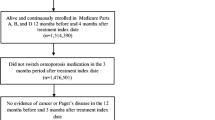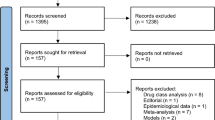Abstract
Background and aims: The effect of risedronate, a potent pyridinyl bisphosphonate, on vertebral fractures in post-menopausal women was evaluated in randomized, placebo-controlled clinical trials. These trials included two large vertebral fracture studies that used time-to-event methods to evaluate the effects of treatment on fracture risk, thereby allowing both the occurrence and the timing of fractures to be considered. Methods: We used individual patient data (IPD) and time-to-event methods to perform a meta-analysis of the anti-fracture efficacy of risedronate (2.5 or 5 mg daily) in osteoporotic women enrolled in five double-blind, placebo-controlled clinical trials. Women were included in the analysis if, at baseline, they had either at least one prevalent vertebral fracture or a femoral neck bone mineral density (BMD) T-score of less than −2.5, were at least 1 year post-menopausal, and had had vertebral fracture assessments (N=3331). Results: Risedronate 5 mg daily reduced the risk of radiographically defined vertebral fracture by 64% (95% CI, 46 to 76%, p<0.001) in the first year of treatment and 45% (95% CI, 31 to 57%, p<0.001) in 3 years. The numbers of patients who needed to be treated with risedronate 5 mg to prevent one new vertebral fracture over 1 and 3 years were 21 and 13, respectively. Comparable findings were observed in sub-populations defined on the basis of either prevalent vertebral fracture without regard to femoral neck BMD, or femoral neck BMD without regard to vertebral fracture status. Risedronate significantly reduced the incidence of clinical (symptomatic) vertebral fractures in the first 6 months of treatment (p<0.001). Conclusions: This meta-analysis, based upon five trials and using IPD and time-to-event statistical methods, provides a more precise estimate of the effect of risedronate in reducing vertebral fracture risk in post-menopausal osteoporotic women than a meta-analysis using summary statistics from the literature.
Similar content being viewed by others
References
Jeng GT, Scott JR, Burmeister LF. A comparison of meta-analytic results using literature vs individual patient data: paternal cell immunization for recurrent miscarriage. JAMA 1995; 274: 830–6.
Duchateau L, Pignon JP, Bijnens L, Bertin S, Bourhis J, Sylvester R. Individual patient-versus literature-based meta-analysis of survival data: time-to-event and event rate at a particular time can make a difference, an example based on head and neck cancer. Controlled Clin Trials 2001; 22: 538–47.
Stewart LA, Parmar MKB. Meta-analysis of the literature or of individual patient data: is there a difference? Lancet 1993; 341: 418–22.
Oxman AD, Clarke MJ, Stewart LA. From science to practice: meta-analyses using individual patient data are needed. JAMA 1995; 274: 845–55.
Eysenck HJ. Meta-analysis or best evidence synthesis? J Eval Clin Practice 1995; 1: 29–36.
Stewart LA, Clarke MJ, on behalf of the Cochrane Working Group. Practical methodology of meta-analysis (overviews) using updated individual patient data. Stat Med 1995; 14: 2057–79.
Harris ST, Watts NB, Genant HK, et al. Effects of risedronate treatment on vertebral and non-vertebral fractures in women with postmenopausal osteoporosis. A randomized controlled trial. JAMA 1999; 282: 1344–52.
Reginster J-Y, Minne HW, Sorensen OH, et al, on behalf of the Vertebral Efficacy with Risedronate Therapy (VERT) Study Group. Randomized trial of the effects of risedronate on vertebral fractures in women with established postmenopausal osteoporosis. Osteoporos Int 2000; 11: 83–91.
FDA CDER. Guidelines for preclinical and clinical evaluation of agents used in the prevention or treatment of postmenopausal osteoporosis. Issued 4/1994. Available at: http://www.fda.gov/cder/guidance/osteo.pdf. Accessed November, 30, 2003.
McClung MR, Bensen W, Bolognese MA, et al. Risedronate increases BMD at the hip, spine, and radius in postmenopausal women with low bone mass. J Bone Miner Res 1997; 12 (Suppk. 1): S169 [Abstract].
Fogelman I, Ribot C, Smith R, Ethgen D, Sod E, Reginster JY. Risedronate reverses bone loss in postmenopausal women with low bone mass. Results from a multinational, double-blind, placebo-controlled trial. J Clin Endocrinol Metab 2000; 85: 1895–900.
Hooper M, Ebeling P, Roberts A, et al. Risedronate prevents bone loss in early postmenopausal women. Calcif Tissue Int 1999; 64(Suppl. 1): S69 [Abstract].
McClung MR, Geusens P, Miller PD, et al. Effect of risedronate on the risk of hip fracture in elderly women. N Engl J Med 2001; 344: 333–40.
World Health Organization. Assessment of fracture risk and its application to screening for postmenopausal osteoporosis. WHO Technical Report Series 843, WHO, Geneva, 1994.
Altman DG. Practical statistics for medical research. London: Chapman & Hall, 1991.
Black DM, Thompson ED, Bauer DC, et al. Fracture risk reduction with alendronate in women with osteoporosis: the fracture intervention trial. J Clin Endocrinol Metab 2000; 85: 4118–24.
Cranney A, Tugwell P, Adachi J, et al. Meta-analysis of risedronate for the treatment of postmenopausal osteoporosis. Endocrine Rev 2002; 23: 517–23.
Author information
Authors and Affiliations
Corresponding author
Rights and permissions
About this article
Cite this article
Adachi, J.D., Rizzoli, R., Boonen, S. et al. Vertebral fracture risk reduction with risedronate in post-menopausal women with osteoporosis: a meta-analysis of individual patient data. Aging Clin Exp Res 17, 150–156 (2005). https://doi.org/10.1007/BF03324588
Received:
Accepted:
Published:
Issue Date:
DOI: https://doi.org/10.1007/BF03324588




